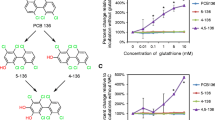Abstract
Administration of toluene and xylenes to rats caused a decrease in liver glutathione concentration. The effect was most pronounced after the administration of o-xylene. 26% of the initial glutathione level was found three hours after treatment with o-xylene (4.0 mmoles/kg).
No in vitro conjugation of o-xylene with glutathione was observed, neither spontaneously nor in the presence of 105,000 g supernatant from rat liver homogenate, containing glutathione S-transferases. Thus, a metabolite of o-xylene, which is not formed during incubation with 105,000 g supernatant, reacts with glutathione.
A thioether was isolated from urine of rats given o-xylene; the compound was identified as o-methylbenzyl mercapturic acid by GC-MS and NMR. Chromatographic evidence was found for the presence of benzyl mercapturic acid in the urine of toluene-treated rats. The amounts of mercapturic acids excreted in the urine after administration of toluene, p-xylene, m-xylene, and o-xylene were 0.4–0.7, 0.6, 1.3, and 10–21% of the dose, respectively.
These results demonstrate the involvement of a thusfar unknown pathway in the biotransformation of toluene and xylenes.
Similar content being viewed by others
References
Angerer, J.: Occupational chronic exposure to organic solvents. VII Metabolism of toluene in man. Int. Arch. Occup. Environ. Health 43, 63–67 (1979)
Arias, I. M., Jakoby, W. B. (eds.): Glutathione: metabolism and function. New York: Raven Press 1976
Bakke, O. M., Scheline, R. R.: Hydroxylation of aromatic hydrocarbons in the rat. Toxicol. Appl. Pharmacol. 16, 691–700 (1970)
Bray, H. G., Humphris, B. G., Thorpe, W. V.: Metabolism of derivatives of toluene. III. o-, m- and p- xylenes. Biochem. J. 45, 241–244 (1949)
Chasseaud, L. F.: Conjugation with glutathione and mercapturic acid excretion. In: Glutathione: metabolism and function. Arias, I. M., Jakoby, W. B. (eds.), pp. 77–114. New York: Raven Press 1976
Chasseaud, L. F.: The role of glutathione and glutathione S-transferases in the metabolism of chemical carcinogens and other electrophilic agents. Adv. Cancer Res. 29, 175–274 (1979)
Clapp, J. J., Young, L.: Formation of mercapturic acids in rats after the administration of aralkyl esters. Biochem. J. 118, 765–771 (1970)
Dean, B. J.: Genetic toxicology of benzene, toluene, xylenes and phenols. Mutat. Res. 47, 75–97 (1978)
Doorn, R. van, Bos, R. P., Leijdekkers, Ch.-M., Wagenaars-Zegers, M. A. P., Theuws, J. L. G., Henderson, P. Th.: Thioether concentration and mutagenicity of urine from cigarette smokers. Int. Arch. Occup. Environ. Health 43, 159–166 (1979)
Ellman, G. L.: Tissue sulfhydryl groups. Arch. Biochem. Biophys. 82, 70–77 (1959)
Gillham, B., Clapp, J. J., Morrison, A. R., Young, L.: The interaction of sulphate esters and glutathione in vivo. Biochem. J. 118, 24P (1970)
Gillham, B.: The reaction of aralkyl sulphate esters with glutathione catalyzed by rat liver preparations. Biochem. J. 121, 667–672 (1971)
Gillham, B.: The mechanism of the reaction between glutathione and 1-menaphthyl sulphate catalyzed by a glutathione S-transferase from rat liver. Biochem. J. 135, 797–804 (1973)
Gorter, E., Graaff, W. C. de: Klinische Diagnostik, p. 440. Leiden: Stenfert Kroese 1955
Hyde, C. W., Young, L.: Biochemical studies on toxic agents. The metabolic formation of 1- and 2-menaphthylmercapturic acid. Biochem. J. 107, 519–522 (1968)
Johnson, M. K.: The influence of some aliphatic compounds on rat liver glutathione levels. Biochem. Pharmacol. 14, 1383–1385 (1965)
Jollow, D. J., Mitchell, J. R., Zampaglione, N., Gillette, J. R.: Bromobenzene-induced liver necrosis. Protective role of glutathione and evidence for 3,4-bromobenzene oxide as the hepatotoxic metabolite. Pharmacology 11, 151–169 (1974)
Jones, A. R.: The metabolism of biological alkylating agents. Drug Metab. Rev. 2, 71–100 (1973)
Mallory, T. B., Gall, E. A., Brickley, W. C.: Chronic exposure to benzene. III. The pathologic results. J. Ind. Hyg. Toxicol. 21, 355–393 (1939)
Ogata, M., Tomokuni, K., Takatsuka, Y.: Urinary excretion of hippuric acid and m- or p-methylhippuric acid in the urine of persons exposed to vapours of toluene and m- or p-xylene as a test of exposure. Br. J. Ind. Med. 27, 43–50 (1970)
Sanita, G.: Benzene-induced hypoplastic anaemia and leukemia. In: Blood disorders due to drugs and other agents. Gorwood, R. H. (ed.). Amsterdam: Excerpta Medica 1973
Vigliani, E. C., Saita, G.: Benzene and Leukaemia. N. Engl. J. Med. 271, 872–876 (1964)
Williams, R. T.: Detoxication mechanisms. 2nd ed. London: Chapman and Hall 1959
Author information
Authors and Affiliations
Rights and permissions
About this article
Cite this article
van Doorn, R., Bos, R.P., Brouns, R.M.E. et al. Effect of toluene and xylenes on liver glutathione and their urinary excretion as mercapturic acids in the rat. Arch. Toxicol. 43, 293–304 (1980). https://doi.org/10.1007/BF00366185
Received:
Issue Date:
DOI: https://doi.org/10.1007/BF00366185




